Hello from the last burst before the year winds down. I’m Diana Kimball Berlin, a partner at Matrix leading concept through Series A rounds in B2B SaaS and AI startups.
Some happy news last week: Meshcapade’s founders won the SIGGRAPH Asia Test-of-Time Award for their work on motion capture. It’s a true joy to back people doing their life’s work.
On the home front, today marks 49 weeks in a row of Diagonal, and next week will mark 50—the last edition of 2024.
And now, five fragments that stuck with me last week…
Even if myself, Alex Graves and other characters in this story did not do deep learning at the time, attention is just the natural way to do flexible spatial connectivity in deep learning. It is a nearly obvious idea that was waiting for GPUs to be fast enough to make people motivated and take deep learning research seriously.
– Dzmitry Bahdanau in a September 10, 2022 email to Andrej Karpathy about the origin story of the attention operator, shared by Andrej on X on December 3, 2024. Since last week’s edition featured an allusion to the apocryphal history of the attention operator being inspired by Arrival, sharing this to do my part to correct the record. But also because I love the format: as Jeff Weinstein once memorably told me, “people love primary source material.”
“Mr. Yamauchi back in the day would tell us that we are not good at fighting: ‘We are weak — so don’t go picking fights with other companies,’” Miyamoto said, explaining the company’s longstanding pursuit of originality.
– Zachary Small, “The Mushroom Kingdom That Shigeru Miyamoto Built,” September 25, 2024, on the opening of the Nintendo Museum in Kyoto. I’ve had this article saved in Readwise for a while; finally got around to reading it and I’m glad I did, since now I have a new bar for competitive self-awareness.
Kinda wish the median person on here wrote 20% worse but with 20% more curiosity/interest/digging about the things their writing is about. Instead of spending that last 20 minutes adding polish, refining word choices, and tightening sentences, maybe Google for a better example, more counterintuitive historical reference, or an extra concept. Or for some types of writing, add a picture, graph, or table. Or a badly drawn cartoon. Or a low-res screenshot of a document or tweet. Unless you’re writing poetry or high-interiority fiction, the marginal value of writerly polish enters indifference zone well before marginal value of content freshness does.
– Venkatesh Rao in a note on Substack, December 3, 2024; first encountered as a screenshot on X. I’ve quoted something similar from Venkatesh here before, so in the meta I’m trying to figure out why the line of thought keeps grabbing me. My best guess is that it’s “the self-help I need,” explaining what I want as a writer in a way that’s self-evident to me as a reader—advice about freshness phrased in a fresh way.
The eight outer spiraling texts start with characters about a centimeter high and end up with characters a few hundred microns high. And the language names surrounding the earth image were small enough we had to get a special engravers style font made in Germany to make sure they would stay legible.
– Alexander Rose, “Macro to micro etching,” The Long Now: Ideas, November 3, 2008. This was an update on the Rosetta Disk Project. I’m fascinated by the challenge of pursuing long-term projects even within an organization dedicated to the long term; this post ends with the text “It took us eight years to get to this point. Whew.”
I feel like any time something is missing anything, it’s soy sauce.
– Niki Nakayama in The Talks, December 23, 2015, found through a footnote on her Wikipedia page. On our trip to LA, we visited her restaurant n/naka and loved it to pieces.
Until next time,
Diana
https://dianaberlin.com





